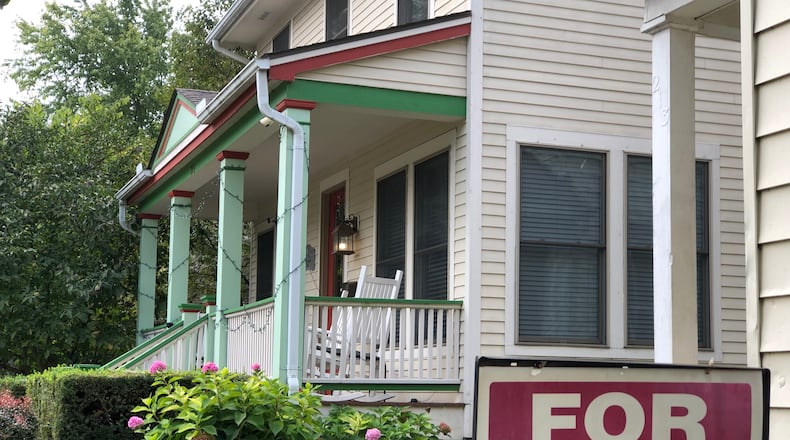There are good tools available to close the affordable housing gap for very or extremely low income renters, but they are woefully underfunded, said Amy Riegel, a Dayton resident who is the executive director of the Coalition on Homelessness and Housing in Ohio.
“They exist and they are working, so there is an opportunity to double down and really start to make an impact,” she said.
Extremely low incomes
The National Low Income Housing Coalition last week released a new Gap Report that found that Ohio has a shortage of about 267,380 housing units that are affordable to extremely low income renters, including a deficit of 18,320 units in the Dayton metro area.
The Buckeye State showed modest improvement in this area, compared to a year ago. The gap isn’t quite as large as it was.
Extremely low income households are those that are below either the federal poverty line or 30% of the area median income. For a family of four, they would have to earn roughly less than $26,700 per year to fall into this category.
The Dayton metro area has about 31,120 extremely low income renters. Another 19,850 local renters are considered very low income, which means their incomes are higher than extremely low income households but less than 50% of the area median income.
A household with four people is considered very low income in the Dayton region if it earns less than $44,500 per year.
The Dayton metro area consists of Montgomery, Miami and Greene counties.
Dayton region
Dayton isn’t as bad off as Ohio’s other metro areas when it comes to its supply of very affordable housing.
A smaller share of local renter households are cost burdened or severely cost burdened than households in Akron, Cincinnati, Cleveland, Columbus and Toledo.
Cost burdened households spend more than 30% of their income on rent and utilities. About 42% of local renter households fall into this category.
Viridis Green, a member of the Dayton Tenant Union who has advocated for the city of Dayton to increase its investments in housing, said last fall that she moved into a three-bedroom rental home in East Dayton in 2021 that cost $850 per month.
Green said her rent jumped to $1,050 and she makes less than $2,000 per month, even though she works 40 hours a week.
Green said the home is in pretty bad shape. But she said finding a new place to live would be challenging because most landlords won’t rent to tenants unless they earn two to three times what they charge in monthly rent.
Helpful tools
Many groups are trying to increase the local supply of affordable housing.
Dayton added housing to the list of things that the city’s Issue 6 income tax levy will pay for, after Green and other community members and tenant union members pushed for that change.
Dayton also has put some of its $138 million in federal COVID relief funds toward improving housing, and the city several years ago approved some renter protections to try to reduce evictions and keep people in their homes, said Riegel, with the Coalition on Homelessness and Housing in Ohio.
Riegel said some the state and federal housing trust funds and low income housing tax credit programs are vital to the development of new affordable housing.
The tax credit programs allow investors to reduce their federal or state tax liabilities in exchange for providing investment equity to develop affordable rental housing, says the Ohio Housing Finance Agency.
Without tax credit subsidies, most affordable housing projects in the program would not be financially feasible, given the low incomes of target residents, says the Urban Institute.
But Riegel said these programs could use a lot more funding.
The state has a $100 million annual credit cap. Housing advocates say expanding the tax credit programs and the housing trust funds would help create more affordable units.
Diane Yentel, president and CEO of the National Low Income Housing Coalition, said it would also help to expand the Section 8 Housing Choice Voucher program, which provides housing assistance for people and families to rent units in the private market.
Greater Dayton Premier Management (GDPM), the local public housing authority, had more than 4,160 families apply for housing vouchers when the waitlist for the Section 8 program opened up last month for five days, said Jennifer Heapy, CEO of GDPM.
“As expected, we saw a large number of families apply for the voucher waiting list,” she said. “Greater Dayton Premier Management remains committed to providing assistance to as many individuals and families as possible. However, as it is across the country, the demand for vouchers often exceeds the available supply.”
Housing advocates say many people who apply for housing vouchers come up empty, with only one quarter of income-eligible households receiving the assistance.
Many voucher-seekers have to wait a long time to get housing assistance, if they get it all.
By the numbers
Dayton metro area
31,125: Number of extremely low income renters
18,320: Shortage of rental housing units for extremely low income renters
41: Affordable and available rental units for every 100 extremely low renter households
21%: Share of all renter households that are severely cost burdened
68% Share of extremely low income renter households that are severely cost burdened
SOURCE: National Low Income Housing Coalition
About the Author






